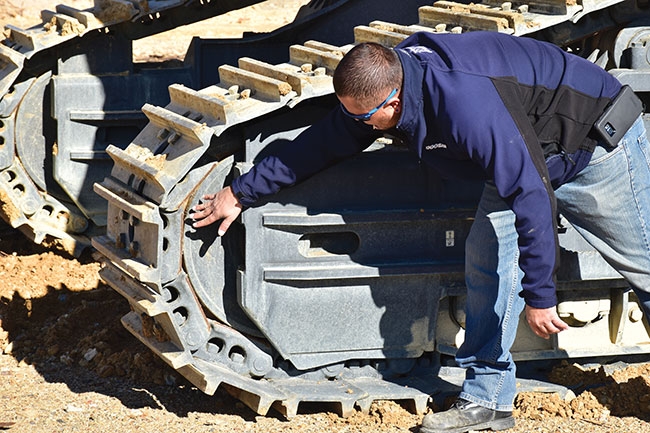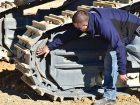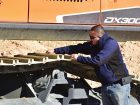
New Gear
Harvesting
New Gear
Five tips for properly maintaining a log loader undercarriage
Nov. 29, 2018 – The undercarriage of tracked heavy equipment, such as log loaders, consists of many moving components that need to be maintained in order for them to function properly. If the undercarriage is not routinely inspected and maintained, it can easily cost valuable time, money and potentially decrease the track’s lifespan.
November 29, 2018 By Aaron Kleingartner
 The undercarriage consists of expensive components. Proper maintenance can help keep overall cost of ownership down and extend the life of your tracks. The undercarriage of tracked heavy equipment
The undercarriage consists of expensive components. Proper maintenance can help keep overall cost of ownership down and extend the life of your tracks. The undercarriage of tracked heavy equipmentBy following these five tips, outlined by Mike Stark, Doosan log loader product specialist, you can get better performance and life out of your log loader’s steel track undercarriage when working in forestry applications.
Tip 1: Keep the undercarriage clean
At the end of each workday, log loader operators should take the time to clean out dirt, sticks and other debris that may lead to undercarriage buildup. Regardless of the application, if the undercarriage is dirty, it needs to be cleaned. If the undercarriage is not routinely cleaned, it will lead to premature wear more quickly on the components. This is especially true in colder climates.
“If operators neglect to clean the undercarriage and are working in a colder climate, the mud and other debris could freeze,” Stark says. “Once that material freezes, it can start to rub on the bolts, move undercarriage components, loosen track guides and seize up the rollers, leading to potential premature wear and then failure later on. Cleaning the undercarriage helps prevent unnecessary downtime.”
Debris can also add additional weight to the undercarriage, reducing fuel economy. Shovels and pressure washers can be used to help clean the undercarriage. Many manufacturers’ undercarriages are designed for easier track carriage cleanout, helping debris fall to the ground rather than become packed in the undercarriage.
Tip 2: Routinely inspect the undercarriage
It is important to complete a full undercarriage inspection for excessive or uneven wear, as well as look for damaged or missing components. According to Stark, if the machine is being used in harsh applications or other challenging conditions, like driving over stumps, the undercarriage may need to be inspected more frequently.
Inspect on a routine basis:
- Drive motor and sprockets
- Idlers and rollers
- Rock guards
- Track bolts, chains and shoes
- Track tension
During a routine machine walk-around inspection, operators should check the tracks to see if any components look out of place. If so, this could indicate a loose track pad or possibly a broken track pin. In addition, they should inspect the rollers, idlers and drives for oil leakage. These oil leaks could indicate a failed seal, which could lead to a major failure in the rollers, idlers or track drive motors.
Always follow your manufacturer’s operation and maintenance manual for proper undercarriage maintenance.
Tip 3: Follow basic practices
Certain jobsite tasks can create more wear on log loader tracks and undercarriages than other applications, so it is important that operators adhere to the manufacturer’s recommended operating procedures.
According to Stark, some tips that can help minimize log loader track and undercarriage wear include:
- Make wider turns: Sharp turns or pivoting the machine can lead to accelerated wear and increase the potential for de-tracking.
- Minimize time on slopes: Constant operation on a slope or hill in one direction can accelerate wear. However, many forestry applications require slope or hillside work, so when moving the machine up or down a hill, make sure that the drive motor is in the correct position to reduce track wear. According to Stark, the drive motor should be facing the back of the machine for easy maneuverability up a slope or hill.
- Reduce unnecessary spinning: Train your operators to make wide, less aggressive turns. Track spinning can lead to accelerated wear and decrease productivity.
- Alternate turning direction: Alternating a log loader’s turning direction can extend undercarriage life.
- Select the correct shoe width: Choose the proper shoe width by considering the machine’s weight, application and geographical location. For instance, if your machines are working in the Pacific Northwest, it may be beneficial to use narrower shoes because they are better suited for hard soil and rocky conditions. However, wide shoes may be needed in regions with soft underfoot conditions.
- Pick the correct grouser: Consider the application before choosing the number of grouser per shoe. A single or double grouser may work well in forestry applications but may not work well in other applications. Typically, the higher number of grousers the track has, the more contact the track will have with the ground, reducing vibration, and the longer it will last when working in more abrasive conditions.
Tip 4: Maintain proper track tension
Incorrect track tension may lead to increased track wear, so it is important to adhere to the proper tension. As a general rule, when your operators are working in soft, muddy conditions, it is recommended to run the tracks slightly looser. “If steel tracks are too tight or too loose, it can quickly accelerate wear,” Stark says. “A loose track could cause the tracks to de-track.”
Refer to your manufacturer’s operation and maintenance manual for correct log loader track-tensioning procedures.
Tip 5: Adhere to proper loading procedures
Your log loader operators should follow basic operating procedures – outlined in your manufacturer’s operation and maintenance manual – to minimize excessive wear and track degradation. Improper operating procedures can cause stress to the track shoes and track links.
The undercarriage consists of expensive components, so adhering to these five undercarriage maintenance tips, as well as proper track maintenance outlined in your manufacturer’s operation and maintenance manual, can help keep your overall cost of ownership down and extend the life of your tracks.
Aaron Kleingartner is the marketing manager for Doosan Infracore North America, headquartered in Suwanee, Ga. www.DoosanEquipment.com.
Print this page

